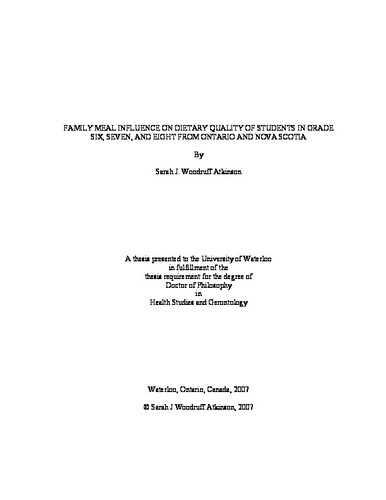| dc.description.abstract | In 2004, Ontario’s Chief Medical Officer of Health Report, Healthy Weights, Healthy Lives (Ministry of Health and Long Term Care, 2004) identified the family (as well as the government, food industry, workplaces, schools, and individuals) for recommendations for action. As a means to promote, achieve, and maintain healthy body weights for both parents and children, Healthy Weights, Healthy Lives (2004) recommended enjoying family meals whenever possible. Very little evidence, however, exists to justify the promotion of family meals within Canada. Therefore, the purpose of this thesis was to describe family meal frequency and meal environments, and to examine the associations with diet quality (as assessed using a Canadian adaptation to the Health Eating Index (HEI-C; Glanville and McIntyre, 2006), and other commonly reported food behaviours and attitudes.
The sample (males=1572 and females=1627) comprised students in grade six (n=1266), seven (n=1359), and eight (n=579) classrooms from Northern Ontario (Porcupine Region n=385), Southern Ontario (Peel Region n=1413, Region of Waterloo n=405, Toronto District n=216), and Nova Scotia (as part of the Physical Activity in Children and Youth (PACY) study n=804) participating in school surveillance-based studies. Data were collected using the web-based Food Behaviour Questionnaire, which included a 24 hour food recall, food frequency questionnaire, and specific questions relating to family meals.
The majority of participants reported frequent family meals (70% on 6-7 days/week, 19% on 3-5 days/week, and 11% on 0-2 days/week). Family meal frequency decreased with increasing grade (X2=30.629 (df=4), p<0.001), and was significantly higher among participants from Porcupine, and lower among participants from Peel (X2=46.815 (df=8), p<0.001). The mean HEI-C score across all participants was 65.1 (SD 13.2) and the majority (73%) were rated in the needs improvement category. Family meal frequency, particularly between 0-2 and 6-7 days/week, was positively associated with diet quality scores (adjusted p=0.045) and ratings (p=0.049). When investigating the person(s) with whom meals were consumed, participants who ate breakfast with family members (versus alone, p=0.012) and/or lunch with friends (versus alone, p=0.007 or with family members, p<0.001) had a significantly greater likelihood of having a better diet quality. Participants who skipped breakfast (p<0.001) and/or lunch (p<0.001) had a greater likelihood of having a worse diet quality than those that consumed each meal.
Cluster K-means procedures were used to classify observations about the four meal environment variables (where the meal was consumed, with whom the meal was consumed, who prepared the meal, and where the food was originally purchased) into groups. A total of 3, 8, and 6 clusters of meal environments were identified for breakfast, lunch, and dinner, respectively. Diet quality was negatively associated with consuming/purchasing meals outside of the home, and skipping breakfast and/or lunch. Meal skipping had a larger impact on overall diet quality than the environmental conditions under which the meal was consumed.
Finally, associations among family meal frequency and other commonly reported food behaviours and attitudes were investigated. Higher family meal frequency was significantly associated with less pop consumption, consuming breakfast on the day of the survey, having higher self-efficacy for healthy eating when at home with family and during social times with friends.
This research, in a large, geographically diverse sample of grade six, seven, and eight students from Ontario and Nova Scotia, found that family meal frequency and specific aspects of meal environments were positively associated with diet quality, and various healthy eating behaviours and attitudes. This research supports the growing body of literature in favour of family meals. Since the diet of most students in grade six, seven, and eight was suboptimal, strategies to promote healthy family meals should be widely encouraged. | en |

